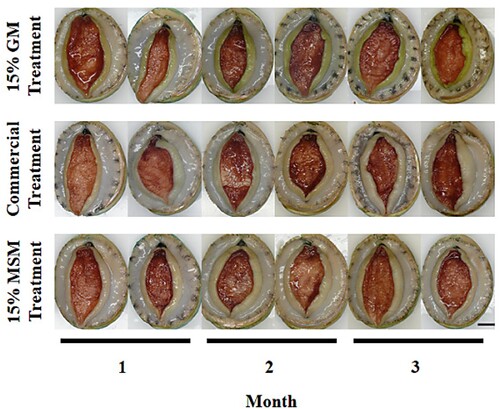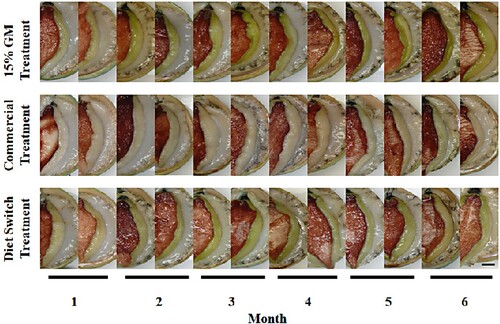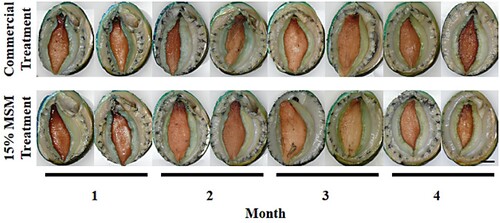Figures & data
Table 1. Proximate composition of mixed species macroalgae (MSM) meal and Gracilaria cliftonii meal and diets used in experimental treatments.
Table 2. Experiment 1 growth performance and feed utilisation for greenlip abalone fed either a commercial diet or a diet formulated to contain 85% of the commercial diet and 15% Gracilaria cliftonii meal or a diet formulated to contain 85% of the commercial diet and 15% mixed species macroalgae (MSM) meal. The three-month laboratory feed trial was carried out to validate experiment 1 on farm feed trial.
Figure 1. Experiment 1 lip and foot colour of greenlip abalone in either the 15% Gracilaria cliftonii meal treatment (formulated to contain 15% G. cliftonii meal (GM) and 85% of commercial diet) or the commercial treatment or the 15% MSM treatment (formulated to contain 15% mixed species macroalgae meal (MSM) and 85% of commercial diet) during a three-month laboratory feed trial. Bar = 1 cm.

Table 3. Experiment 1 colour properties of lip, foot and shell of greenlip abalone fed either a commercial diet or a diet formulated to contain 85% of the commercial diet and 15% mixed species macroalgae (MSM) meal or a diet formulated to contain 85% of the commercial diet and 15% Gracilaria cliftonii meal during a three-month laboratory feed trial.
Table 4. Growth performance and feed utilisation for greenlip abalone fed either a commercial diet or a diet formulated to contain 85% of commercial diet and 15% Gracilaria cliftonii meal during the preconditioning phase (months one to three) of a six-month phase feeding trial. During this phase the switched treatment was identical to the 15% G. cliftonii meal.
Figure 2. Experiment 2 lip colour for greenlip abalone in either the 15% Gracilaria cliftonii meal treatment (formulated to contain 15% G. cliftonii meal (GM) and 85% of commercial diet) or the commercial treatment or the diet switch treatment during a six-month phase feeding trial. During the first phase (months one to three) of the trial, the diet switch treatment was the 15% G. cliftonii meal diet, and switched to the commercial diet during the second phase (months four to six). Bar = 1 cm.

Table 5. Experiment 2 colour properties of lip, foot and shell of greenlip abalone fed either a commercial diet or a diet formulated to contain 85% of the commercial diet and 15% Gracilaria cliftonii meal during the preconditioning phase (months one to three) of a six-month phase feeding trial. The switched treatment was identical to the 15% G. cliftonii meal during this phase.
Table 6. Growth performance and feed utilisation for greenlip abalone fed either a commercial diet or a diet formulated to contain 85% of commercial diet and 15% Gracilaria cliftonii meal during the second phase (months four to six) of a six-month phase feeding trial. During this phase the switched treatment was identical to the commercial diet.
Table 7. Growth performance and feed utilisation for greenlip abalone fed either a commercial diet or a diet formulated to contain 85% of the commercial diet and 15% Gracilaria cliftonii meal during a six month phase feeding trial. During the first phase (months one to three) of the trial, the diet switch treatment was in the 15% G. cliftonii meal diet and switched to the commercial diet during the second phase (months four to six).
Table 8. Experiment 2 colour properties of lip, foot and shell of greenlip abalone fed either a commercial diet or a diet formulated to contain 85% of commercial diet and 15% Gracilaria cliftonii meal during the diet switch phase (months four to six) of a six month phase feeding trial. During this phase the switched treatment was identical to the commercial diet treatment.
Figure 3. Experiment 3 lip and foot colour of greenlip abalone in either the commercial treatment or the 15% MSM treatment (formulated to contain 15% mixed species macroalgae meal (MSM) and 85% of commercial diet) during a four-month on-farm feed trial. Bar = 1 cm.

Table 9. Experiment 3 growth performance for greenlip abalone fed either a commercial diet or a diet formulated to contain 85% of the commercial diet and 15% mixed species macroalgae (MSM) meal in a four-month on-farm feed trial.
Table 10. Experiment 3 colour properties of lip, foot and shell of greenlip abalone fed either a commercial diet or a diet formulated to contain 85% of the commercial diet and 15% mixed species macroalgae (MSM) meal during a four-month on farm feed trial.
